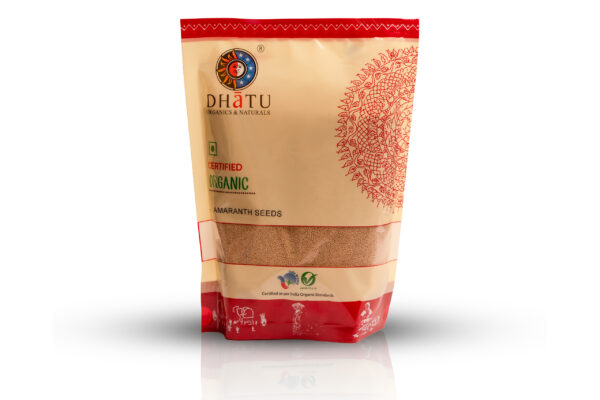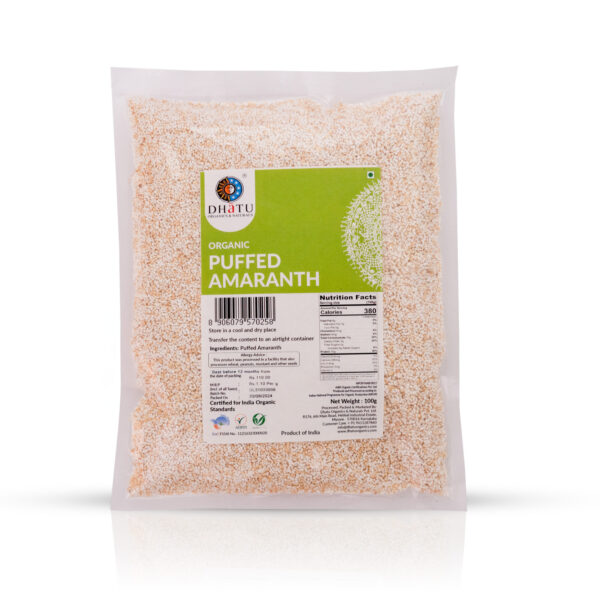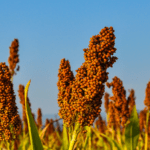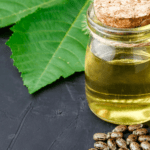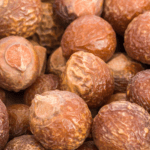
Amaranth – The Immortal Grain!
Amaranth grains have been cultivated for thousands of years – from the time of the Incas and Indus Valley civilisations. The prominence given to this food by our ancient civilizations can be gauged by its name alone!
Amaranth can be split into two words – Amara + Anthos. Amara means immortal in both Sanskrit and Greek. Anthos means flower. Our ancestors figured out that Amaranth is a nutrient powerhouse where both grains and leaves can be consumed with immense health benefits. Thus the name Amaranth!
A Revered Grain!
In India, Amaranth is also known as Rajgira or Ramdana. Now, Ram-Dana means god’s own grain! Rajgira means the grain of Kings!
Ayurvedic texts, including the Charaka Samhita and Sushruta Samhita, classified it as a “satvic” food, meaning it is spiritually purifying, making it ideal for fasting and religious observances. Known as Tanduliyaka in Sanskrit, it is used for improving digestion and boosting stamina.
Culturally, it is used in the fasting of religious significance, particularly during Navaratri and Ekadashi. No wheat or rice grains are permitted during fasting practive, but Amaranth is allowed! This shows that amaranth was and is a revered grain in India.
Ancient civilizations, from Greece to India, realised the importance of this grain! Only science is now catching up!
Promotes Skin Health due to High Squalene Content:
Amaranth has the highest oil content when compared with other seeds or grains. It has about 6-9% oil by weight!. This oil content is relatively high for a grain and is notable for its high concentration of squalene (up to 8% of the total oil), unsaturated fatty acids, and tocopherols (Vitamin E).
Squaline is normally extracted from shark liver oil and is of immense health benefits.
- It enhances the skin’s lipid barrier, supporting hydration, elasticity, and protection from UV-induced skin damage.
- Reduces skin pigmentation and inflammation
- It is used by the body to synthesize cholesterol and steroid hormones, which are crucial for immune function.
Anti-inflammatory Properties:
- Including amaranth (in the form of grains or flour) in the daily diet is a great idea. The active compounds in amaranth, including squalene and tocopherols (Vitamin E), stimulate the body’s antioxidant enzymes, reducing oxidative stress, a known factor in chronic diseases like cancer, diabetes, and neurodegenerative diseases.
- Regular consumption of amaranth can reduce pro-inflammatory cytokines, reducing pain and inflammation in joint diseases. Linoleic acid and other PUFAs, which are known to modulate inflammation are responsible for this action.
Promotes Liver Health:
Amaranth helps reduce the fat accumulation in the liver and enhance lipid metabolism. This helps in preventing the onset of non-alcoholic fatty liver disease (NAFLD). Further, squalene present in the amaranth helps maintaining liver enzyme levels at optimum. Thus reducing liver inflammation and fibrosis!
Helps in Diabetes Management:
Regular intake of Amaranth improves insulin sensitivity and lowers blood glucose levels. The antioxidant properties of amaranth help in reducing glycation – a process that aggravate diabetes complications.
Neuroprotection
The oil component of the Amaranth contains squalene and PUFAs that helps protect neurons from oxidative stress, which is linked to neurodegenerative diseases like Alzheimer’s and Parkinson’s. Animal studies suggest amaranth oil may enhance memory and reduce markers of inflammation in the brain. It may also improve cognitive function by maintaining cellular membrane integrity and improving neurotransmitter function.
What makes amaranth a superfood?
Amaranth is considered a superfood due to its high protein content (including all essential amino acids), abundant dietary fiber, and rich supply of vitamins, minerals, and antioxidants like squalene. It’s also naturally gluten-free, making it suitable for those with gluten intolerance or celiac disease. The nutrients in amaranth support heart health, digestive health, and immune function, making it a nutrient-dense choice.
How was amaranth used in ancient India?
Amaranth has been part of Indian culture for centuries, especially in Ayurveda and traditional fasting practices. Known as “Rajgira” or “Ramdana,” it was used as a staple food and is often included in fasting diets due to its satvic (pure) quality. Ancient Ayurvedic texts refer to it for its health benefits, and it continues to be used today in dishes like laddoos, puris, and chapatis during festivals and fasts.
Is amaranth good for digestion and metabolism?
Yes, amaranth supports digestion and metabolism. Its high fiber content aids in digestion, while the presence of specific amino acids, like lysine, supports muscle and tissue repair. Additionally, the dietary fiber in amaranth promotes satiety, which can aid in weight management and help regulate blood sugar levels.
Does cooking affect the nutritional value of amaranth?
Cooking amaranth does result in some nutrient loss, particularly for water-soluble vitamins. However, many of its essential nutrients, like protein, fiber, and minerals, remain largely intact. To preserve antioxidants and vitamins, cooking methods like steaming or light sautéing are preferable to boiling.
How can I incorporate amaranth into my diet?
Amaranth is versatile and can be used in various ways: cook the whole grains as a porridge or side dish, use amaranth flour (rajgira atta) for baking, or add it to soups and salads for a nutrient boost. For a traditional approach, try making rajgira puris or laddoos, which are popular in Indian fasting and festive foods.
Organic Amaranth Seeds 500g
Organic Amaranth Seeds 500g Discover the ancient superfood with our premium Organic Amaranth Seeds. Naturally gluten-free and packed with essential nutrients like protein, fiber, and iron, these tiny seeds offer a powerhouse of health benefits. Perfect for porridge, salads, or baking, they provide a wholesome addition to your everyday diet.
Organic Puffed Amaranth 100g
Dhatu Organic’s Puffed amaranth: a light, crunchy superfood rich in protein, fiber, and essential minerals. Perfect for adding to snacks, cereals, and desserts for a nutritious boost! Know More: https://dhatuorganics.com/2024/10/26/amaranth-the-immortal-grain/
References:
Panda, V. S., & Naik, S. R. (2009). Squalene–A natural antioxidant: Potential and therapeutic perspectives. Alternative Medicine Review, 14(1), 59-64.
Berger, A., et al. (2003). Cholesterol-lowering properties of amaranth grain and oil in hamsters. Food Chemistry, 81(1), 119-124.
Zheleznov, I. L., et al. (2011). Amaranth as a source of anti-inflammatory bioactives. Functional Foods in Health and Disease, 1(7), 293-305.
Flanagan, V. P., et al. (2000). Functional properties of squalene as an antioxidant and anti-inflammatory. Biochemical Pharmacology, 59(10), 1211-1219.
Raju, R., & Verma, S. C. (2014). Liver protective effects of amaranth oil on high-fat diet-induced NAFLD in animal models. Journal of Medicinal Food, 17(7), 757-765.
Martirosyan, D. M., & Miroshnichenko, L. A. (2003). The functional role of amaranth oil on lipid metabolism. Journal of Nutraceuticals, Functional & Medical Foods, 4(3-4), 43-65.
Barba de la Rosa, A. P., et al. (2009). Amaranth oil and its effect on glycemic response and insulin sensitivity in diabetic rats. Food and Function, 1(1), 56-63.
Menéndez-Aguirre, O., et al. (2016). Effect of squalene on insulin resistance and blood glucose levels. Journal of Functional Foods, 21, 335-346.
Singh, R., & Devasagayam, T. P. (2007). Neuroprotective effects of amaranth oil in an oxidative stress model. Journal of the Science of Food and Agriculture, 87(10), 1914-1922.
Discover more from Dhatu
Subscribe to get the latest posts sent to your email.

